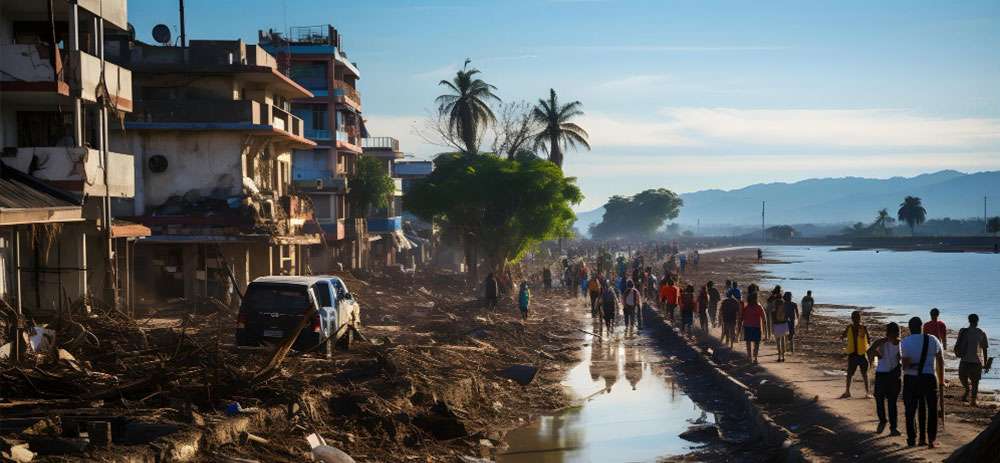Introduction
Urban flooding has become an increasingly critical issue in India, with major cities such as Mumbai, Chennai, Bengaluru, and Hyderabad frequently experiencing devastating floods. The rapid expansion of urban areas, coupled with poor drainage systems, unplanned construction, and climate change, has exacerbated the problem. The 21st century has witnessed several catastrophic urban floods, highlighting the urgent need for sustainable urban planning and effective disaster management.
This blog explores the causes of urban flooding in India, examines recent disasters, and discusses the lessons that can be drawn to mitigate future risks.
Causes of Urban Flooding
Urban flooding is primarily caused by a combination of natural and human-induced factors:
- Unplanned Urbanization
Indian cities are expanding at an unprecedented rate. However, this growth is often unregulated, leading to the encroachment of natural water bodies, wetlands, and floodplains. These areas act as natural buffers against flooding, and their loss results in poor water absorption and excessive surface runoff. - Poor Drainage Infrastructure
Many Indian cities rely on outdated and inadequate drainage systems that cannot handle heavy rainfall. Clogged and poorly maintained drains further worsen the situation, leading to waterlogging and flash floods. - Climate Change and Extreme Weather Events
Climate change has increased the frequency and intensity of extreme rainfall events. The Indian monsoon, which brings a significant portion of the annual rainfall, is becoming more erratic, leading to prolonged dry spells followed by intense downpours that overwhelm drainage systems. - Encroachment of Lakes and Riverbanks
Lakes and rivers have historically played a crucial role in managing excess rainfall. However, rapid urbanization has led to the encroachment of these water bodies for real estate development. As a result, natural drainage channels are obstructed, exacerbating flood risks. - Inadequate Urban Planning and Governance
A lack of proper urban planning, weak enforcement of building regulations, and poor coordination among municipal authorities contribute to urban flooding. Unauthorized constructions and land-use changes without proper drainage considerations worsen the problem.
Recent Urban Flood Disasters in India
Several Indian cities have faced severe flooding in recent years, exposing vulnerabilities in urban infrastructure and disaster preparedness. Some major incidents include:
-
- Mumbai Floods (2005 & 2021)
- In July 2005, Mumbai received an unprecedented 944 mm of rainfall in a single day, resulting in severe flooding that claimed over 1,000 lives. The failure of the city’s drainage system, coupled with illegal constructions, worsened the crisis.
- In 2021, heavy rains once again led to widespread flooding, bringing the city to a standstill. The Mithi River, which serves as a key drainage channel, was heavily encroached upon, leading to poor water flow and inundation.
- Chennai Floods (2015 & 2023)
- The 2015 Chennai floods were one of the worst disasters in recent history, triggered by record-breaking rainfall and the mismanagement of water reservoirs. The encroachment of wetlands and poor urban planning were major contributing factors.
- In 2023, parts of Chennai were submerged again, highlighting the persistent vulnerabilities despite lessons from past events.
- Bengaluru Floods (2022)
- In September 2022, Bengaluru witnessed massive urban flooding due to heavy rains and poor drainage infrastructure. The city’s IT corridors, which house major tech firms, were severely affected. The flooding was attributed to encroachments on storm water drains and lakes.
- Hyderabad Floods (2020)
- Hyderabad experienced severe floods in October 2020 following unprecedented rainfall. The city’s drainage system failed to cope with the deluge, leading to the submergence of roads and residential areas. The encroachment of water bodies and poor waste management played a key role in worsening the disaster.
Lessons from Recent Disasters
Each urban flood disaster in India underscores the need for immediate and long-term measures to prevent and mitigate future incidents. Here are key lessons that policymakers and urban planners must prioritize:
- Strengthening Drainage Infrastructure
Cities need modern drainage systems designed to handle extreme rainfall. Regular maintenance, desilting, and expansion of existing stormwater drains should be a priority. Smart drainage solutions, including rainwater harvesting and underground water storage, can help manage excess water.
- Restoration of Natural Water Bodies
Encroached lakes, wetlands, and rivers must be reclaimed and restored. These natural water systems act as sponges, absorbing excess rainwater and reducing flood risks. Strict enforcement of land-use regulations is essential to prevent further encroachments.
- Improved Urban Planning and Zoning Regulations
Urban planning must incorporate flood-resilient designs. Buildings should not be constructed on floodplains, and permeable surfaces must be increased to allow water absorption. Cities should implement zoning laws that restrict construction in flood-prone areas.
- Disaster Preparedness and Early Warning Systems
Efficient early warning systems and real-time weather monitoring can help in timely evacuations and preparedness. Public awareness campaigns and community involvement in flood management can enhance disaster resilience.
- Sustainable Drainage Solutions
Cities should adopt nature-based solutions such as green roofs, rain gardens, and bio-swales to manage urban runoff. Sustainable drainage systems (SuDS) can help in reducing surface water flooding while improving groundwater recharge.
- Enhanced Coordination Between Government Agencies
Urban flood management requires a multi-agency approach. Collaboration between municipal corporations, water resource departments, disaster management authorities, and environmental agencies is crucial for effective response and mitigation.
- Use of Technology and Data-Driven Decision Making
GIS mapping, remote sensing, and AI-based flood prediction models can help in identifying flood-prone areas and designing effective flood mitigation strategies. Smart city initiatives should integrate these technologies for better flood resilience. - Implementation of Sponge City Concepts
The ‘sponge city’ concept, successfully implemented in China, focuses on increasing urban permeability through green infrastructure. Indian cities should adopt similar approaches, incorporating parks, wetlands, and open spaces to absorb excess rainfall.
Conclusion
Urban flooding in India is a growing challenge that demands urgent attention and sustainable solutions. While climate change and extreme weather events are beyond human control, cities can significantly reduce their flood risks through better planning, infrastructure development, and governance. Learning from past disasters and implementing proactive measures can pave the way for flood-resilient urban environments.
India’s future urban growth must prioritize water-sensitive development, resilient infrastructure, and community participation to ensure that cities remain habitable and safe in the face of increasing climate uncertainties.



